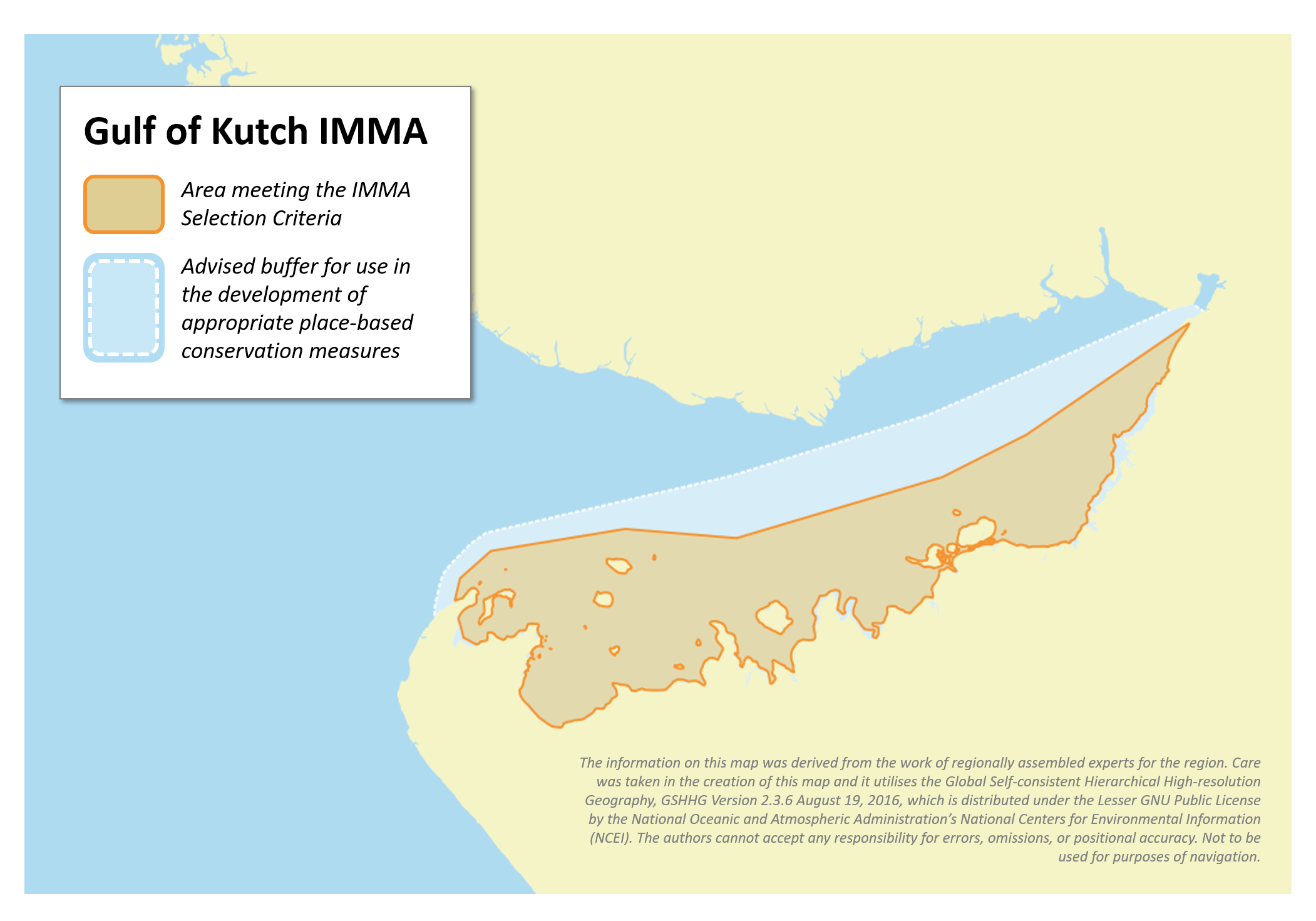Gulf of Kutch IMMA
Size in Square Kilometres
2 677 km2
Qualifying Species and Criteria
Dugong – Dugong dugon
Criterion A; B (1); C (2)
Indian Ocean humpback dolphin – Sousa plumbea
Criterion A
Marine Mammal Diversity
Dugong dugon, Neophocaena phocaenoides, Sousa plumbea
Download fact sheet
Summary
The Gulf of Kutch Marine Protected area is home to small and declining populations of dugongs (Dugong dugon), Indian Ocean humpback dolphins (Sousa plumbea) and finless porpoises (Neophocaena phocaenoides). While very few dedicated cetacean studies have been carried out to cover the entire IMMA, the sea grass beds and dugong populations have been assessed intensely since 2012. Dugong grazing trails as well as recent sightings and stranding events have been documented in this area, where seagrass beds are under constant pressure from industrial growth along the coast. Dugongs were locally hunted in the past though this has now stopped. However, fisheries entanglement is still a serious threat. Scattered groups of Indian Ocean humpback dolphins are present in the IMMA throughout the year; calves have been documented; and stranding events of both Indian Ocean humpback dolphins and finless porpoises have been reported from the area.
Description of Qualifying Criteria
Criterion A – Species or Population Vulnerability
Dugongs are globally Vulnerable and Indian Ocean humpback dolphins are globally Endangered. While the population size is probably very low (in the twenties for Dugongs and less than 100 for Indian Ocean humpback dolphins), two dead dugongs stranded on Ajad island and Positra Bay in 2018-19. These dugongs might have died due to fishing net entanglement (Pathan Sameeha, Pers Communication). Fishing entanglement, vessel traffic, habitat fragmentation and degradation due to anchoring, docking, dredging are the major threats to dugongs and cetaceans in here (Sivakumar and Nair, 2013, Sutaria and Jefferson 2004, MMRCNI, 2019).
Criterion B: Distribution and Abundance
Sub-criterion B1: Small and Resident Populations
In the Gulf of Kutch line transect survey of 2002 (Sutaria and Jefferson 2004), 21 groups of S. plumbea were sighted during a search effort of 570 km. This gives a very low sighting rate of 0.037 groups/km. A total of 15 groups were sighted along the coast, and six groups were sighted around the islands with an estimate of less than 80 animals. Since then no other systematic survey of the Gulf for Sousa has been carried out. Dugong populations as stated above are small, declining and resident in the Gulf of Kutch. Quantitative data on the size of the Dugong population is not available but interview based survey conducted by the GEER Foundation suggested that 10 to 15 dugongs might still be using the Gulf of Kutch. Local extirpation of the dugong population is very likely in the near future if their habitat is not protected and entanglements in fishing gear is not mitigated.
Criterion C: Key Life Cycle Activities
Sub-criterion C2: Feeding Areas
The area is further recognized as a ‘Critical Dugong Habitat’ in Gujarat. Grazing trails have been observed or documented in six sea grass beds showing that the area is a particularly important feeding habitat for the small remaining population of Dugongs in the region. All of the foraging grounds have young stands of Halophila and Halodule sp. of seagrasses growing.
Supporting Information
Anonymous, 2012. ‘National Conservation Strategy and Action plans for Dugongs and their habitats in India.’ Ministry of Environment, Forests and Climate Change, New Delhi.
Apte, D., D. Parasharya & B. Patel. 2019. Feeding trails of Dugong Dugong dugon (Müller, 1776) (Mammalia: Sirenia: Dugongidae) in the Gulf of Kachchh, western coast of India. Journal of Threatened Taxa 11(1): 13151–13154; https://doi.org/10.11609/jott.4315.11.1.13151-13154
Pathan, S. 2019. Field Report Submitted to the CAMPA Dugong Recovery Project, Wildlife institute of India, Dehradun, India.
Sivakumar, K. and Nair, A. 2013. Dugong Distribution, Habitat and Risks Due to Fisheries and Other Anthropogenic Activities in India. Wildlife Institute of India – Technical Report. 1-74
Sutaria, D., Panicker, D., Jog, K., Sule, M., Muralidharan, R., and Bopardikar, I. 2015. Humpback Dolphins (Genus Sousa) in India: An Overview of Status and Conservation Issues. In ‘Conservation status of Humpback Dolphins (Sousa spp.). T.A.Jefferson and B.E.Curry (Ed.) Advances in Marine Biology Series. Vol. 72. Elsevier/Academic Press.
Sutaria, D., Arthur, R., & Satashivam, K. 2014. Marine mammals in subcontinental waters. In Mammals of South Asia: Johnsingh, A. J. T. & Manjrekar, N. (Ed.). New Delhi: Permanent Black.
Sutaria, D., and Jefferson, T. A. 2004. Records of Indo-Pacific Humpback Dolphin (Sousa chinensis Osbeck, 1765) along the coast of India and Sri Lanka – An Overview. Aquatic Mammals Special Issue 30(1) 125-136
MMRCNI 2019. Database on Sousa plumbea and Neophocaena phocaenoides from Gujarat: www.marinemammals.in


